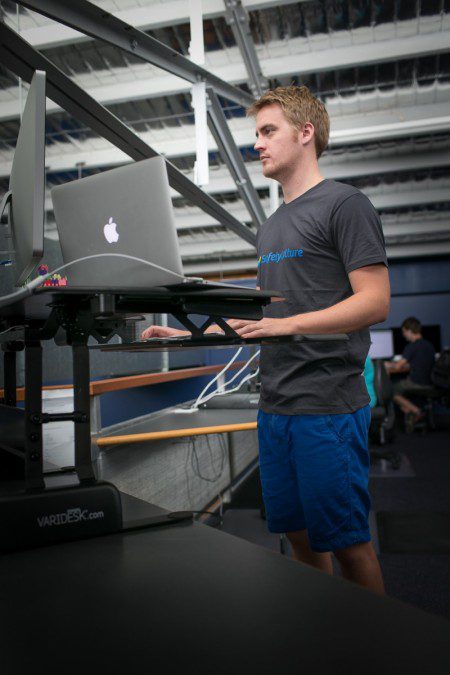Stand the Test of Time: Why sitting down can lead to an early grave
Industry Trends | By | 28 Oct 2014 | 3 minute read

Sitting down all day is really, really bad for you.
It’s something we’ve heard about for a while, but recent studies have confirmed that sitting down can reduce your lifespan while increasing the risk of cancer, heart disease, and diabetes.
While we won’t go as far as to put warning labels on our Lay-Z-Boys, there is some cause for concern.
But how can sitting all day be avoided for people in, say, an office environment? The average office worker sits for about 5 hours and 41 minutes every work day, which can have an effect regardless of our exercise habits outside of these hours.
It’s all well and good to get some exercise in your spare time, but if you’re still spending your whole working day sitting, you’re at risk. In fact, one study suggests that every hour spent sitting reduces our lifespan by a staggering 22 minutes.
[Tweet “Every hour spent sitting reduces our lifespan by a staggering 22 minutes.”]
On the back of more recent statistics released by the Cancer Council on the ill effects of prolonged sitting in the workplace, we here at SafetyCulture have embraced a more active office space, employing the use of stand up desks.
Stand up desks have been proven to stimulate blood flow, reduce circulatory issues, increase energy levels, while reducing the risk of heart disease, obesity, diabetes, and some cancers.
Two Varidesk stand up desks were brought into the office two months ago as a trial to gauge how many people wanted to get one. Almost 60% of our employees decided to give it a go.
 The Rubber Mat cushions and supports your feet, knees, hips and back while you work.
The Rubber Mat cushions and supports your feet, knees, hips and back while you work.After just two weeks of the stand up desks, along with a thick rubber mat for standing on to cushion the feet, I gauged some of the feedback around the office, with some of the comments listed below.
“Whenever I get fidgety, I can just stand up and keep working.”
“I find I’m not falling asleep at 3.30 anymore. In fact, it’s probably my most energetic time of the day.”
“I have more energy and after the initial break in period, I’m finding it a lot better for my back too.”
It’s not recommended to go from sitting all day to standing for a whole 8 hours. It’s a gradual process. There’s an adjustment period where you can get your body used to being in that position. That’s the best thing about stand up desks, you can adjust them straight back down and sit whenever you like.
When Dwight from the hit tv show The Office gets a stand up desk, he likens his still seated colleagues to a “suicide cult”. While obviously an extreme example, the man does have a point.
 The Varidesk in action. Sit to Stand in three seconds.
The Varidesk in action. Sit to Stand in three seconds.A study from the Medicine & Science in Sports & Exercise journal as far back as 2009 has found that those who sit for most of the day were 54% more likely to die of heart attacks. The study examined 17,000 men and women over 13 years, and the statistic reigned true even if the people were regular exercisers and non-smokers. This has lead to the increasingly popular slogan “sitting is the new smoking”.
[Tweet “Those who sit for most of the day are 54% more likely to die of heart attacks.”]
While it’s easy to be swept up in the sensationalism surrounding sitting down for long periods, it is hard to look past the data. What’s the alternative? Less than $500 for a stand up desk, while looking a bit weird for a statistically longer life?
I say it’s better to look weird than to die young.
Extra tips for increasing the amount of movement in your day:
- Walk with a colleague before or after work
- Walk or cycle to the local shops instead of driving
- Catch public transport, get off one stop early and walk the rest of the way
- Take your family for a bushwalk on the weekend or challenge them to a game of backyard cricket
- Try a new hobby such as boxing, golf, swimming or touch football
For more ideas visit quest.org.au
More information about Cancer Council Queensland is available at www.cancerqld.org.au or 13 11 20.
Author: Jarrod Boyd
Important Notice
The information contained in this article is general in nature and you should consider whether the information is appropriate to your specific needs. Legal and other matters referred to in this article are based on our interpretation of laws existing at the time and should not be relied on in place of professional advice. We are not responsible for the content of any site owned by a third party that may be linked to this article. SafetyCulture disclaims all liability (except for any liability which by law cannot be excluded) for any error, inaccuracy, or omission from the information contained in this article, any site linked to this article, and any loss or damage suffered by any person directly or indirectly through relying on this information.





